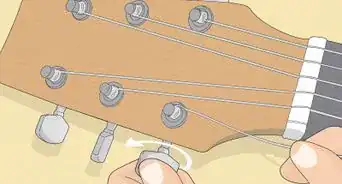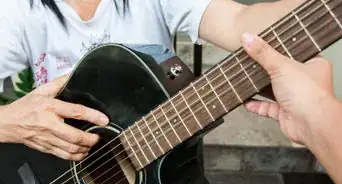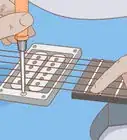This article was co-authored by wikiHow staff writer, Kira Jan. Kira Jan earned her B.A. in English from Stanford University in 2021. She has published work in a variety of literary magazines and edited for bestselling authors. Kira now writes and edits for the content team at wikiHow with the goal of reaching audiences of all backgrounds, skillsets, and interests. She enjoys continually learning alongside wikiHow readers and working to create connection through the written word.
There are 24 references cited in this article, which can be found at the bottom of the page.
This article has been viewed 10,986 times.
Learn more...
The large Mexican guitar (guitarrón) is a key instrument in the rich tradition of mariachi music. However, guitar techniques essential to Mexican music include strumming patterns and rhythms that you can learn on the guitarrón, vihuela (a smaller version of the guitarrón), or regular guitar.[1] With consistent practice, you can pick up the Mexican guitar strumming patterns and techniques that give mariachi its distinct, vibrant sound! To help you get started playing this vibrant music style, we’ve compiled answers to the most commonly asked questions about picking up Mexican guitar.
Steps
What guitar do you need to play Mexican guitar?
-
1To play traditional Mexican guitar, buy a vihuela or guitarrón. Choose the guitarrón if you’d like to provide the bass in mariachi music, or choose the vihuela if you’re interested in a higher-pitched, smaller version of the guitarrón. Typically, you’ll play the guitarrón by plucking strings (like you would on a bass guitar), whereas you’ll strum a vihuela. [2]
- Use a finger pick (that slides onto your index finger) to play the vihuela.[3]
- The vihuela may be easier to pick up if you already play guitar because it has the same tuning as a normal guitar, without the bass E string. The guitarrón uses an entirely different tuning.
-
2Alternatively, use a nylon-string or classical guitar. You’ll be able to learn the same strumming patterns and rhythms. Don’t use an acoustic, steel-string guitar. The stiffer strings will make it more difficult to learn fast picking and strumming.[4]
- Use a thick plectrum (regular) pick to produce the strong, vibrant sound associated with mariachi.
How do you hold a Mexican guitar?
-
1Use your knee or guitar strap to hold the guitar upright. If the guitar sits too low on your lap, try standing with your leg propped up on a stool. Your bent knee will act as a little shelf for the guitar to sit higher. If you’d like to stand without a stool, use a guitar strap at a length where your guitar feels most comfortable for you. No matter how you hold the guitar, be sure to stand or sit with good posture.[7]
- To comfortably play your larger guitarrón, hold the body at an angle so that the face of the guitar is tipped towards you.[8]
-
2Use a relaxed right right arm and wrist. Relaxing your arm and wrist will help you strum quickly and produce the intense sound of mariachi music. Your wrist should be bent towards the strings. Don’t keep your arm straight, with your wrist parallel to the instrument.[9] You can prop your right forearm on the lower bout of the guitar for stability.[10]
-
3Hold your left hand around the neck of the guitar. Let your thumb wrap around the back of the guitar’s neck so you can use it to play bass notes.[11]
How do you play a huapango strumming pattern?
-
1For huapangos, you’ll play a complex pattern in 3/4 time. The rhythm is 2 measures long (six beats total), so it’s best to start by learning the first measure. In the first measure, you’ll play a rhythm of one quarter note, followed by two eighth notes and another two eighth notes. Let’s break that first measure down into each individual beat:[22]
- To play the first beat, make a single downstroke.
- To play the second beat, play a rasgueo (raking your fingers over the strings) followed by an apagón (muting the strings with your palm).
- For beat three, return to regular strumming with a down stroke and an up stroke.
- Note that a rasgueado or rasgueo is also called abanico or folding fan technique. To play a rasgueo, let all your right-hand fingers drag across the strings as you strum. Practice getting your fingers to fan out smoothly over the strings so that they hit evenly. [23]
-
2Break the second measure of the huapango into three beats. This time, you’ll incorporate sixteenth notes (which are twice as fast as eighth notes).[24]
- First, you’ll play an eighth note apagón and two sixteenth notes using a down-down-up pattern.
- For beat two, you’ll play two eighth notes. You’ll play a down stroke apagón and then a regular down stroke.
- For beat three, you’ll play two eighth notes again with a simple down-up strum pattern.
References
- ↑ https://web.nmsu.edu/~lleeper/pages/Voice/marrujo/history.htm
- ↑ https://www.youtube.com/watch?v=7usJ7trJcEg&t=273s&ab_channel=LutherBurbankCenterfortheArts
- ↑ https://www.youtube.com/watch?v=MC8bDocrZfM&t=27s&ab_channel=OpenSauceGuitar
- ↑ https://www.youtube.com/watch?v=7eYAA3LoQpw&ab_channel=JasonDavenport
- ↑ https://stringedinstrumentdatabase.aornis.com/v.htm
- ↑ https://stringedinstrumentdatabase.aornis.com/g.htm
- ↑ https://www.youtube.com/watch?v=bsIaVMvedcQ&t=100s&ab_channel=JasonDavenport
- ↑ https://www.youtube.com/watch?v=kstmJ_1VS8A&t=151s&ab_channel=Mariachingl%C3%A9s
- ↑ https://www.youtube.com/watch?v=MC8bDocrZfM&t=155s&ab_channel=OpenSauceGuitar
- ↑ https://www.youtube.com/watch?v=bsIaVMvedcQ&t=203s&ab_channel=JasonDavenport
- ↑ https://www.youtube.com/watch?v=bsIaVMvedcQ&t=272s&ab_channel=JasonDavenport
- ↑ https://www.youtube.com/watch?v=NvKAoWODDSk&t=228s&ab_channel=RicardoDollero
- ↑ https://www.youtube.com/watch?v=NvKAoWODDSk&ab_channel=RicardoDollero
- ↑ https://www.youtube.com/watch?v=T43zrOJjHkU&t=72s&ab_channel=OpenSauceGuitar
- ↑ https://www.youtube.com/watch?v=MC8bDocrZfM&t=141s&ab_channel=OpenSauceGuitar
- ↑ https://www.youtube.com/watch?v=MC8bDocrZfM&t=233s&ab_channel=OpenSauceGuitar
- ↑ https://www.youtube.com/watch?v=T43zrOJjHkU&t=196s&ab_channel=OpenSauceGuitar
- ↑ https://www.youtube.com/watch?v=m2GvYZrNbd0&ab_channel=OpenSauceGuitar
- ↑ https://www.youtube.com/watch?v=cgHZ_m6ta0M&t=3s&ab_channel=OpenSauceGuitar
- ↑ https://www.youtube.com/watch?t=103&v=cgHZ_m6ta0M&feature=youtu.be&ab_channel=OpenSauceGuitar
- ↑ https://www.youtube.com/watch?v=cgHZ_m6ta0M&t=186s&ab_channel=OpenSauceGuitar
- ↑ https://www.youtube.com/watch?v=SqnKTScQ6No&t=395s&ab_channel=Mariachingl%C3%A9s
- ↑ https://www.youtube.com/watch?v=SqnKTScQ6No&t=162s&ab_channel=Mariachingl%C3%A9s
- ↑ https://www.youtube.com/watch?v=SqnKTScQ6No&t=601s&ab_channel=Mariachingl%C3%A9s








































































